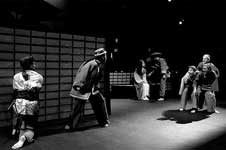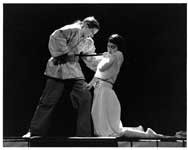|
Adapatation, Design and Directing of "Love Suicide at Amijima" by Chikamatsu Monzaemon, 1996 |
||||||

First Act: Jihei endures taunts, while Koharu
and the "Samurai" confer in secret
|

Third Act: The Double Suicide takes place: Jihei
kills Koharu before hanging himself
|
|||||
The adaptation: Chikamatsu wrote his play for the Bunraku theater, a fascinating theatrical form existing to this day, which utilizes almost life-size puppets. All dialogues and an insightful and poetic commentary are performed by the tayu, a narrator, the role of which has developed into an art form in itself. One of the aspects of my adaptation of this play was to adapt it to actors, rather than to use puppets. This has been done before, with many Kabuki plays having in fact been written for Bunraku. I did not want, however, to lose the narrative, which is a fully developed and important voice within the play. As a reference to the black-clad “puppeteers” in Bunraku, I created a chorus whose costumes were based on the “invisible” black garb of the highly skilled puppet manipulators. I divided the narrative commentary among the chorus to create characters – one chorus member received all of the condemning and judgmental commentary and was thus the “strict” commentator, while the other received the lines that are compassionate, thus the “empathizing” commentator. The chorus would strike rosewood blocks, which would cause all action to freeze dramatically on stage. While the actors stood still as statues, the chorus would launch into discussions, sometimes addressing the audience directly. Again, this “freezing” was a form of paying homage to Edo period theater, as Kabuki actors often stop in mid-action to hold a pose, emphasizing the drama of the moment. This technique added a dimension to the rhythm of the play, which was exciting to work with.
|
||||||
Web Design by
Nicolas Roeper
All artworks/images copyright Jan Sawka

